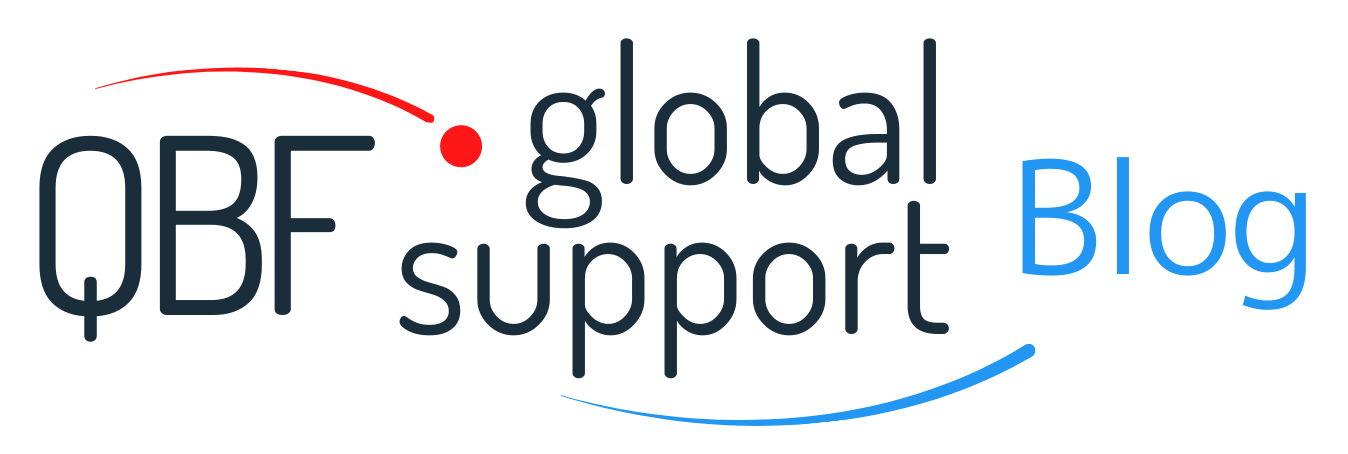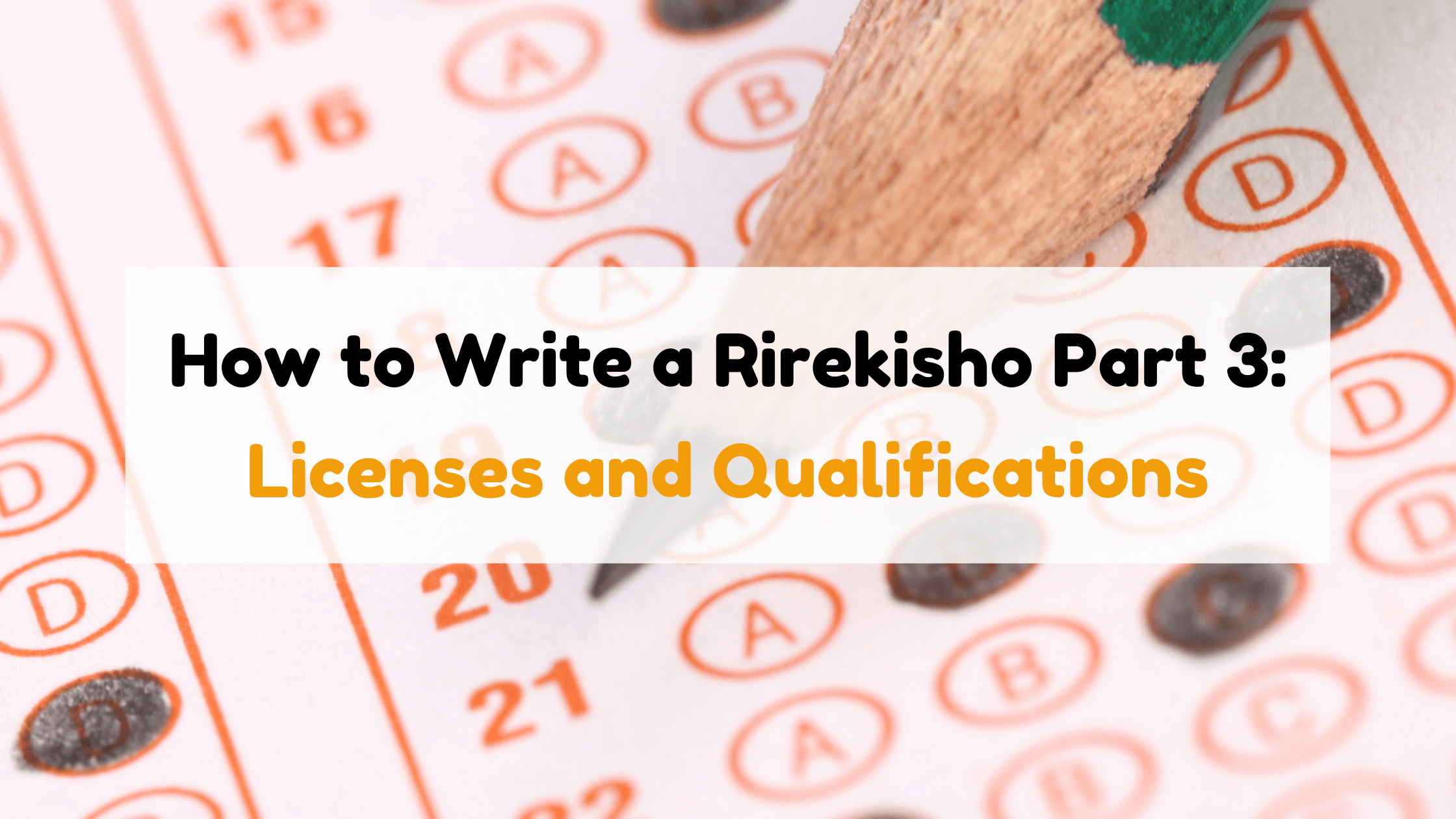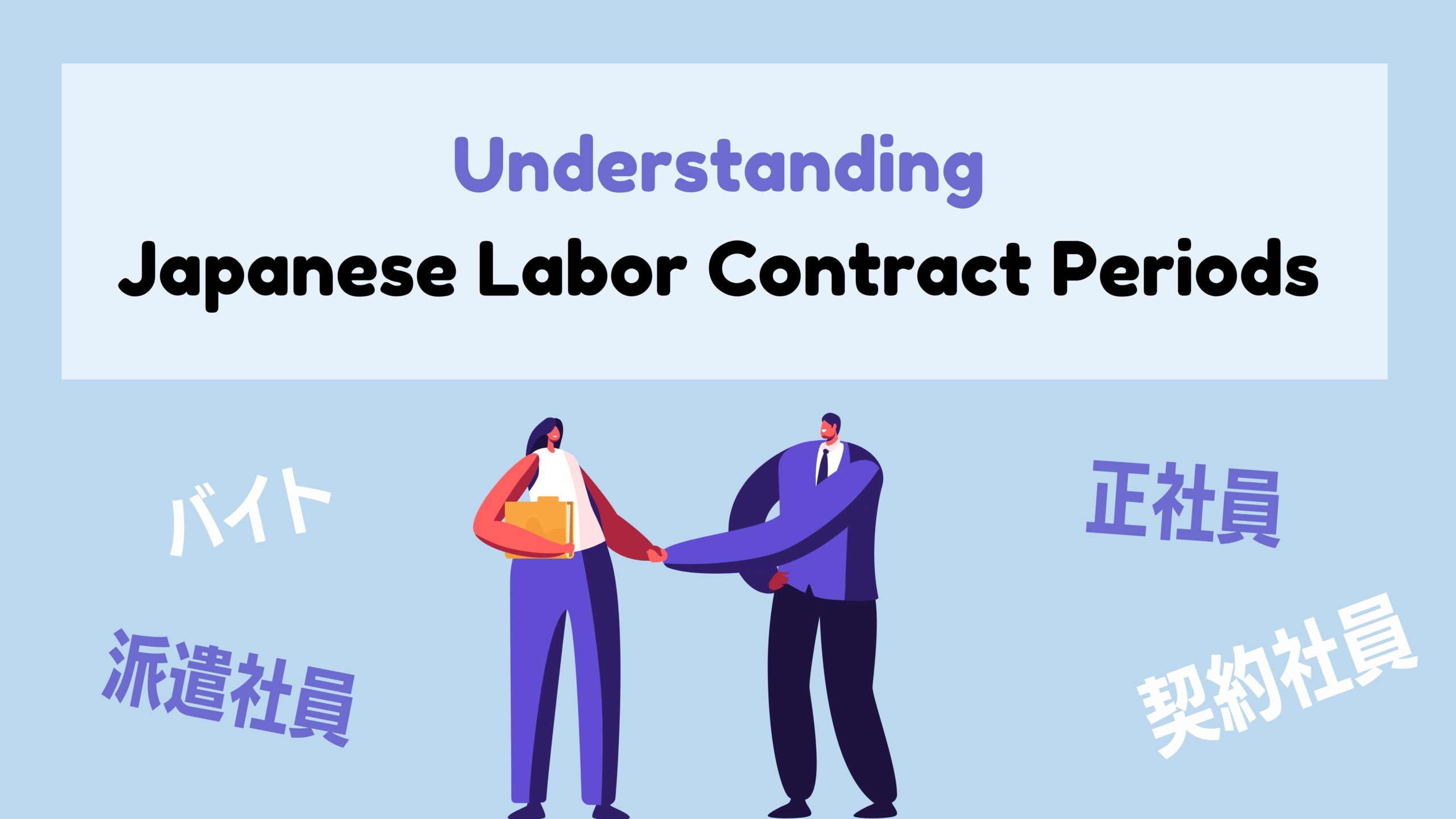This is the third part in our series on How to Write a Japanese Rirekisho, or Japanese resume.
This article will explain how to create the third part of the rirekisho – the Licenses and Qualifications section, titled as 免許・資格 (Menkyo / Shikaku) in Japanese.
If you are writing a Japanese resume (rirekisho), and you haven’t already, we suggest you start by reading our previous articles from this series:
Writing a Rirekisho Part 1: How to Write Personal Information Section
Writing a Rirekisho Part 2: How to Write Education and Work History (Gakureki / Shokureki)
Difficulty Rating ★★★☆☆
Overview of the Licenses and Qualifications Section
What is the Licenses and Qualifications Section for?
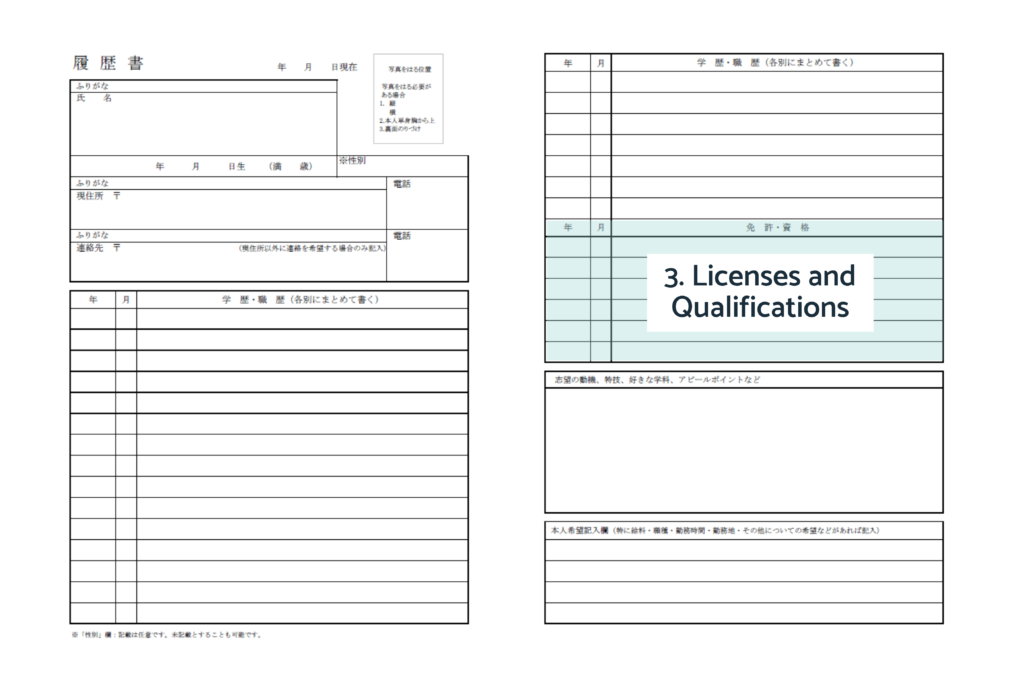
The licenses and qualifications section is a place on the rirekisho solely dedicated to listing any licenses and qualifications that you might hold.
You can also use this space to indicate licenses and qualifications you are currently working towards, or plan to take in the very near future.
Qualifications and licenses tend to fall into four main categories
1. Field specific licenses and qualifications
2. Language qualifications
3. Driver’s licenses
4. Computer qualifications
1. Field Specific Licenses and Qualifications

These are licenses and qualifications you have acquired during your career or for your career, that are not part of higher education.
These could include things like pilot licenses, teaching licenses / TEFLs, or real estate licenses, for example.
Keep your list relevant to the role
Refer back to the job description to guide you. If you hold a lot of different licenses and qualifications, this may mean narrowing down your list.
2. Language Qualifications

For Japanese and other non-native English speakers jobseekers, this is a chance to mention English language qualifications such as TOEIC or IELTs.
For foreigners looking to work in a Japanese company, this is an opportunity to list any Japanese language qualifications you hold, such as:
Japanese Language Proficiency Test 日本語能力試験
Business Japanese Test BJTビジネス日本語能力テスト
Kanji Kentei 日本漢字能力検定
If you have any other language certificates besides Japanese and English that might be relevant to the job you are applying for, you can list those, too.
Only list the highest level of a test that you hold
For example, if you took JLPT N3, and then a year later you took N2, you would write your N2 result.
3. Driver’s Licenses

If you have a Japanese driver’s license, be sure to list it under Licenses and Qualifications.
Many Japanese companies ask staff to do 外出 (outside work) for a variety of reasons, which requires them to operate a company car.
Japan has a whopping 15 kinds of driver’s licenses, so you need to confirm which you have before writing it on your rirekisho.
Check what kind of drivers license you hold by referring to the bottom of your Japanese license.
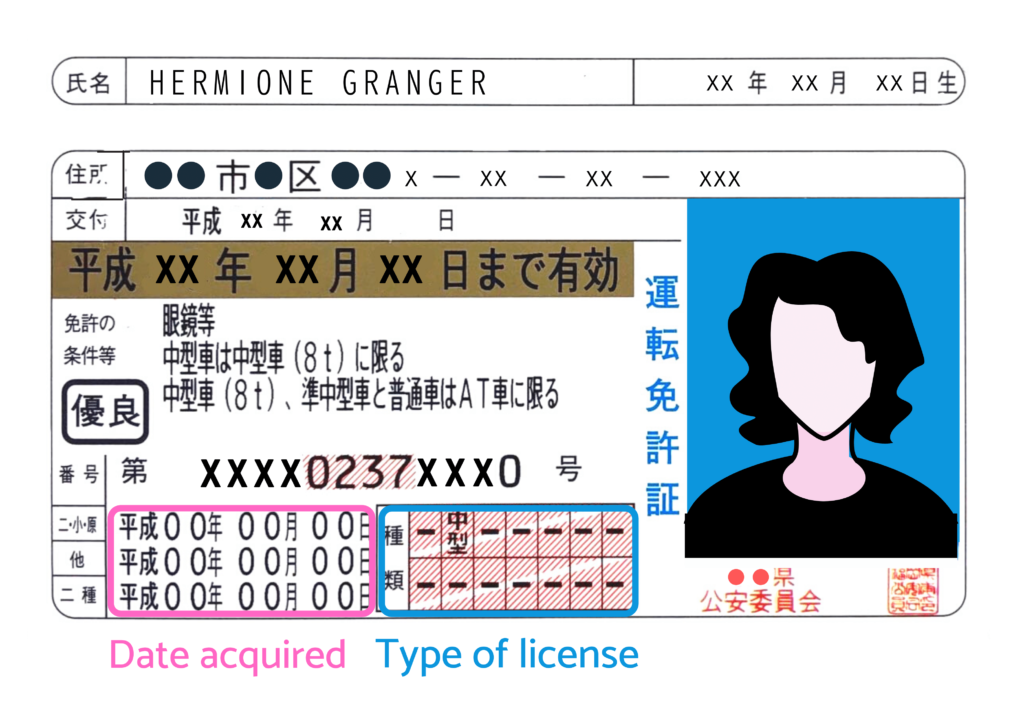
In the above example, the license type is 中型 (chugata) which is an abbreviation of 中型運転免許 (medium-sized vehicle license).
Because your resume is an official document, you need to list your license type in complete terms.
See the chart below to find out the official name of your license.
Official names of the 15 types of Japanese driver's licenses
大型 (ogata) Heavy vehicle license :大型自動車免許
中型 (chugata) Medium-sized vehicle license:中型自動車免許
準中型 (junchu-gata) Quasi-medium-sized vehicle license:準中型自動車免許
普通 (futsu) Ordinary driver’s license:普通自動車免許
大特 (daitoku) Large-scale special vehicles license:大型特殊自動車免許
大自二 (daiji-ni) Large motorcycle license:大型自動二輪車免許
普自二 (shinji-ni) Ordinary motorcycle license:普通自動二輪車免許
小特 (kotoku) Compact special vehicle license:小型特殊自動車免許
原付 (gentsuki) Moped license:原動機付自転車免許
け引 (kenin) Towing license : 牽(けん)引免許
大二 (dai-ni) Commercial heavy vehicle license (type II):大型自動車第二種免許
中二 (chu-ni):Commercial medium vehicle license (type II) 中型自動車第二種免許
普二 (shin-ni):Commercial ordinary vehicle license (type II) 普通自動車第二種免許
大特二 (daitoku-ni):Large special vehicle license (type II) 大型特殊自動車第二種免許
け引二 (kenin-ni) Towing license (type II):牽(けん)引第二種免許
Type II licenses are those that give the holder permission to drive as a service (i.e. bus and taxi drivers)
List your license even if you assume you won’t need it at work
Even if you assume you won’t be asked to do ‘outside work’, you should still write down that you hold a license, just in case.
The same goes for “paper drivers”. Even if you are not in the habit of driving, still let your potential employer know that you hold a license.
Don’t list motorcycle licenses here
If you hold a motorcycle license, it should not be listed here. You can list this under hobbies instead (unless motorcycles are directly related to the job!)
3. Computer Qualifications

In Japan, the MOS (Microsoft Office Specialist) Certification is extremely popular with people of working age. Around 4 million people hold the certificate as of 2021.
It is therefore another common entry under Licenses and Certificates on the rireksho.
You can list any computer certifications you might hold, taken in Japan or your home country.
If you are good with computers but don’t have a certificate
You can talk about these in the skills or hobbies section, or on the shokumukeirekisho instead.
How to Structure the Licenses and Qualifications section
For each entry, you will need to input the following information:
– The official name of the qualification / license
– Any score given if applicable
– Either the word 取得 (obtained) or 合格 (passed)
General guidelines for when writing:
Date formatting can be either Japanese or Western, as long as it is consistent with the rest of the resume
Write the full and official title of a license or qualification.
For example, 日本語能力試験 rather than JLPT N1 / N2 etc.
A good rule of thumb for the ordering is: driver’s license followed by qualifications related to your field, language qualifications and then computer qualifications
Use one line per license / qualification
DO include licenses and qualifications you are still working on or planning to take in the near future
When to Write 取得 (Obtained) and When to Write 合格 (Passed)

取得 (obtained) is usually used used for licenses (免許), and things which have a score.
For example:
・Driver’s licenses
・Teaching licenses
・TOEIC
合格 (passed) is usually used for qualifications (試験 / 検定)
For example:
・Language tests besides TOEIC (JLPT, Eiken etc.)
・Computer qualifications (MOS etc.)
Some variations of 取得 (obtained) / 合格 (passed)
修了:Used for lectures (講義) and training workshops (講習)
登録:Used for practical experience in the legal world (税理士)
免状:Used for safety related examinations (such as for electricians)
Examples of how to list different kinds of licenses and qualifications
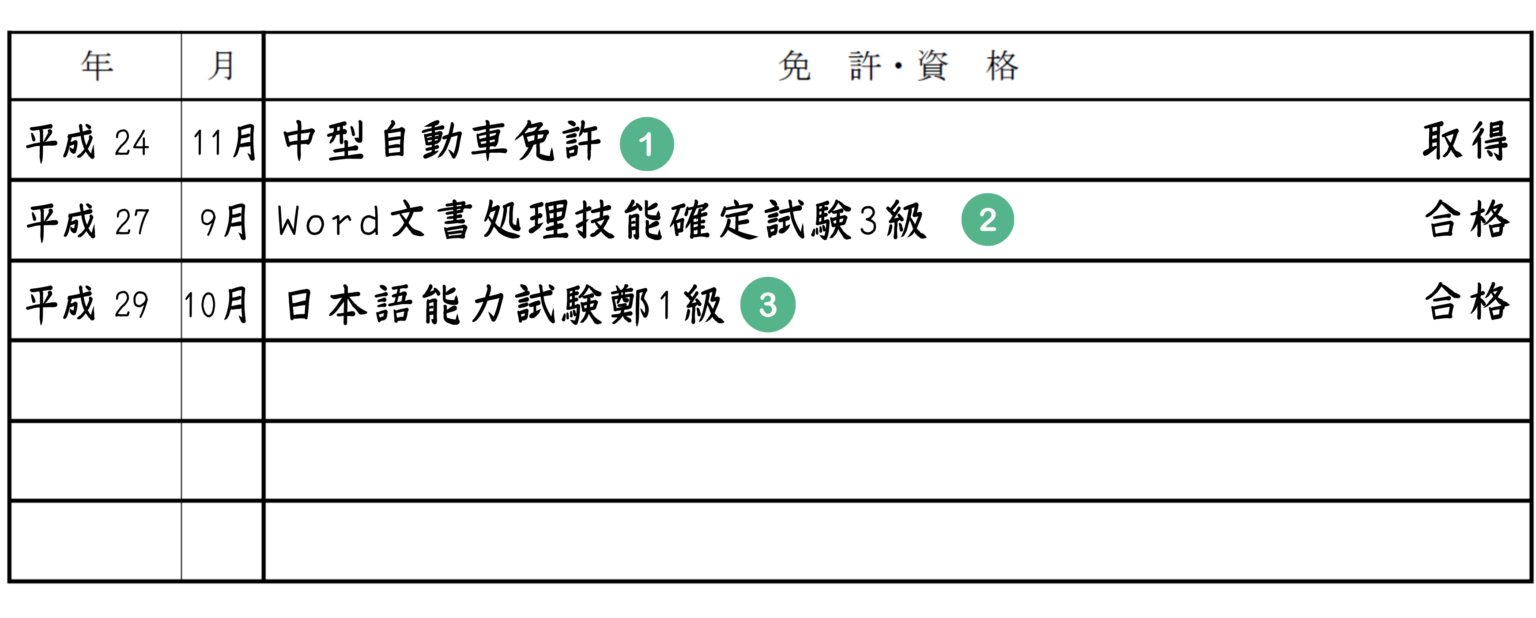
1. Driver’s License
・ Check your license to confirm the date acquired and the type of license.
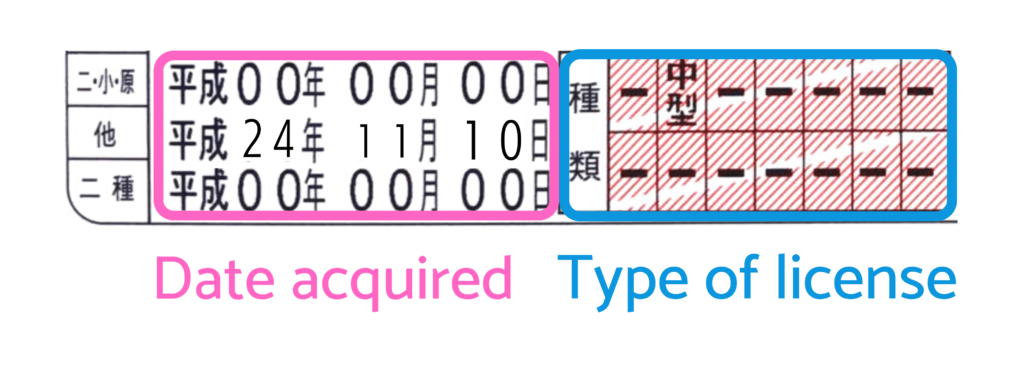
・ Input the month and year obtained in to the date columns.
・ In the wide column, write the official name for the license
(In this case 中型 becomes 中型自動車免許)
・ To the far right of the row, write 取得 (obtained).

2. Computer Qualification
・ Input the month and year obtained in to the date columns.
・ In the wide column, write the official name for the qualification
・Write the score (in this case 3級)
・To the far right of the row, write 合格 (passed).

3. Language Qualification
・Input the month and year obtained in to the date columns.
・ In the wide column, write the official name for the qualification
・Write the score (in this case 1級)
・To the far right of the row, write 合格 (passed).

Checking the official name of a license or qualification
If you aren’t sure the official name for a qualification, try inputting the name you know in to google, followed by the words 正式名称
When you have no licenses or qualifications
All sections of the resume need to be filled out, so even if you have nothing to mention, you should write the word なし or 特になし to indicate this.
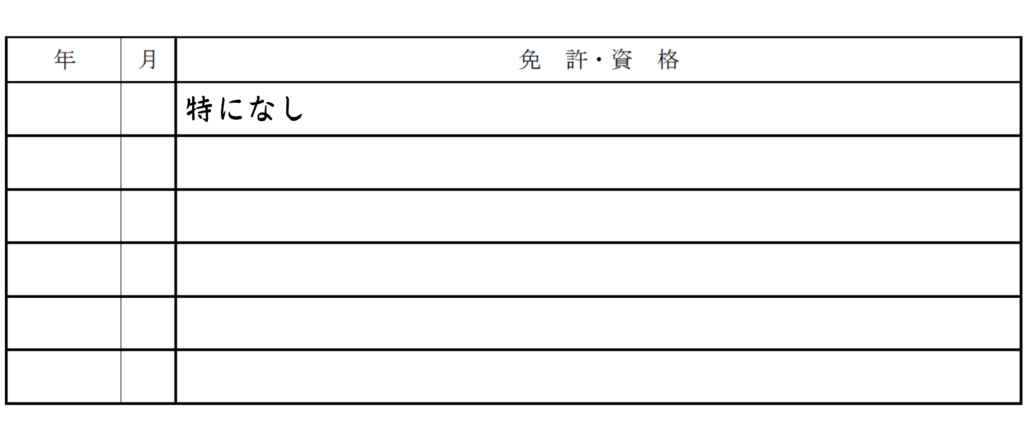
How to list something you’re still studying
It’s a good idea to list licenses and qualifications that you are in the process of completing.
You can format this using the following structure:
○○資格取得に向けて勉強中
In the next part in the series, we will take a deep dive into the fourth section of the rirekisho –
志望の動機、特技、好きな学科、アピールポイント
In this section you can talk about yourself in a little more detail, as well as explain your reasons for wanting to work for a company.
